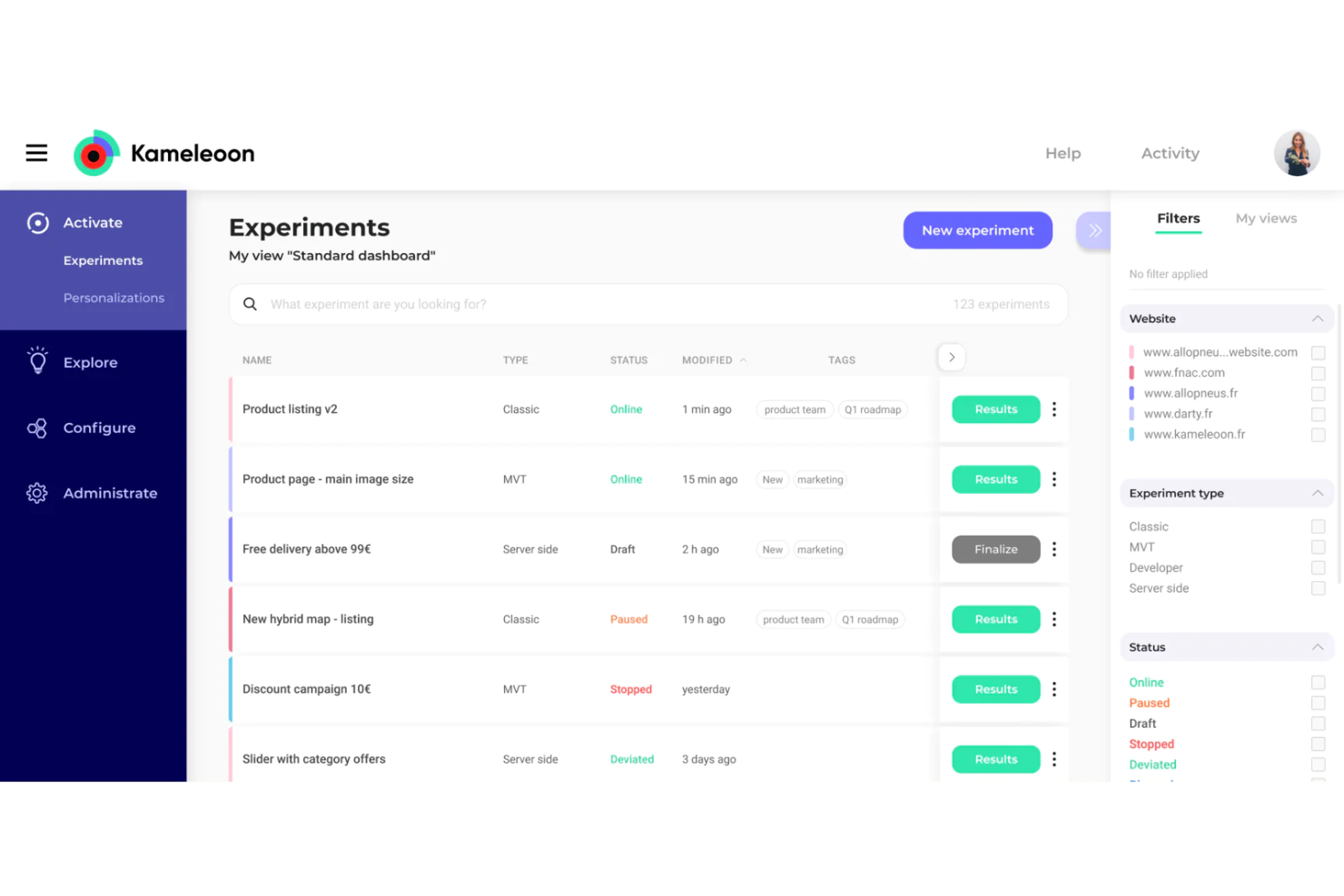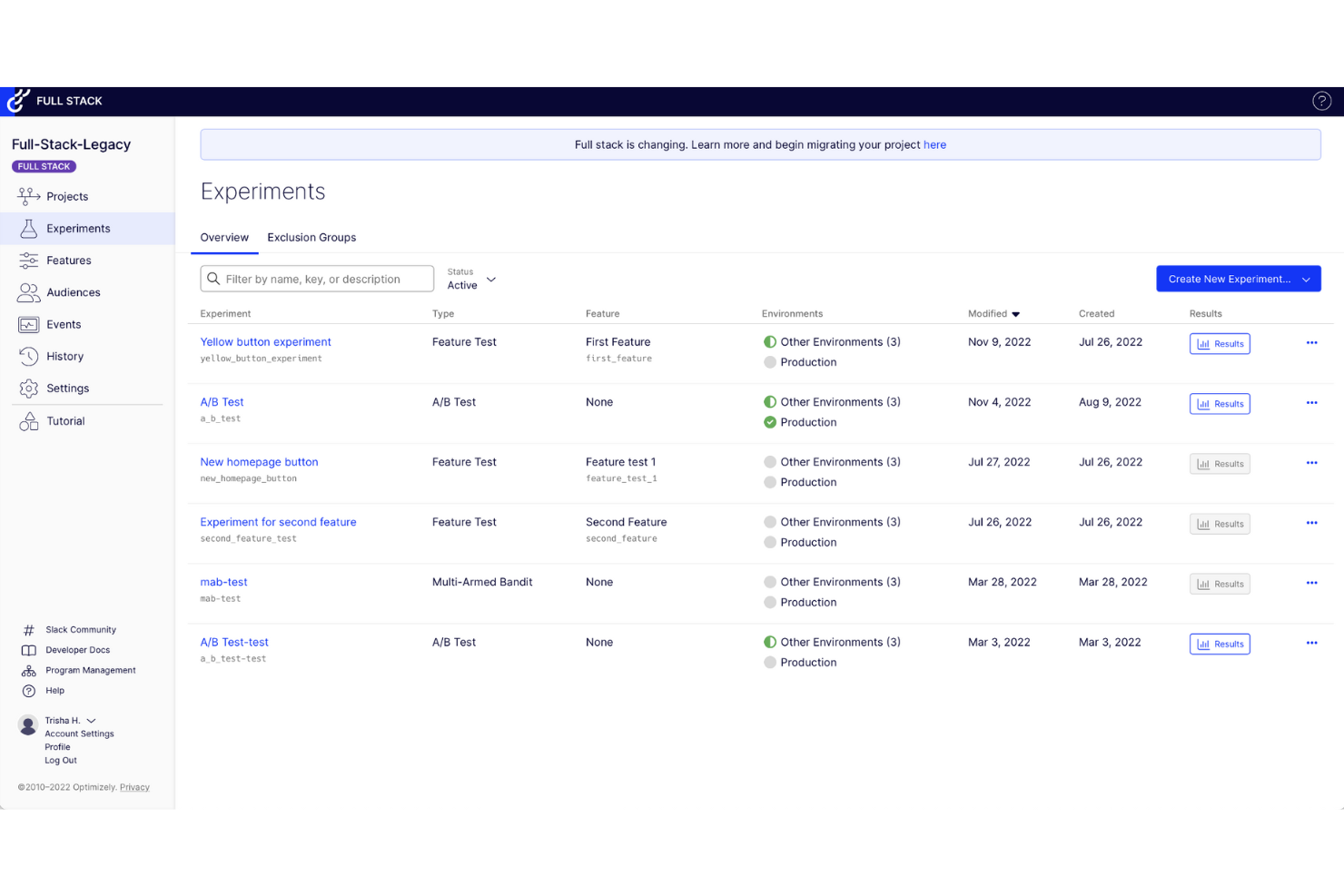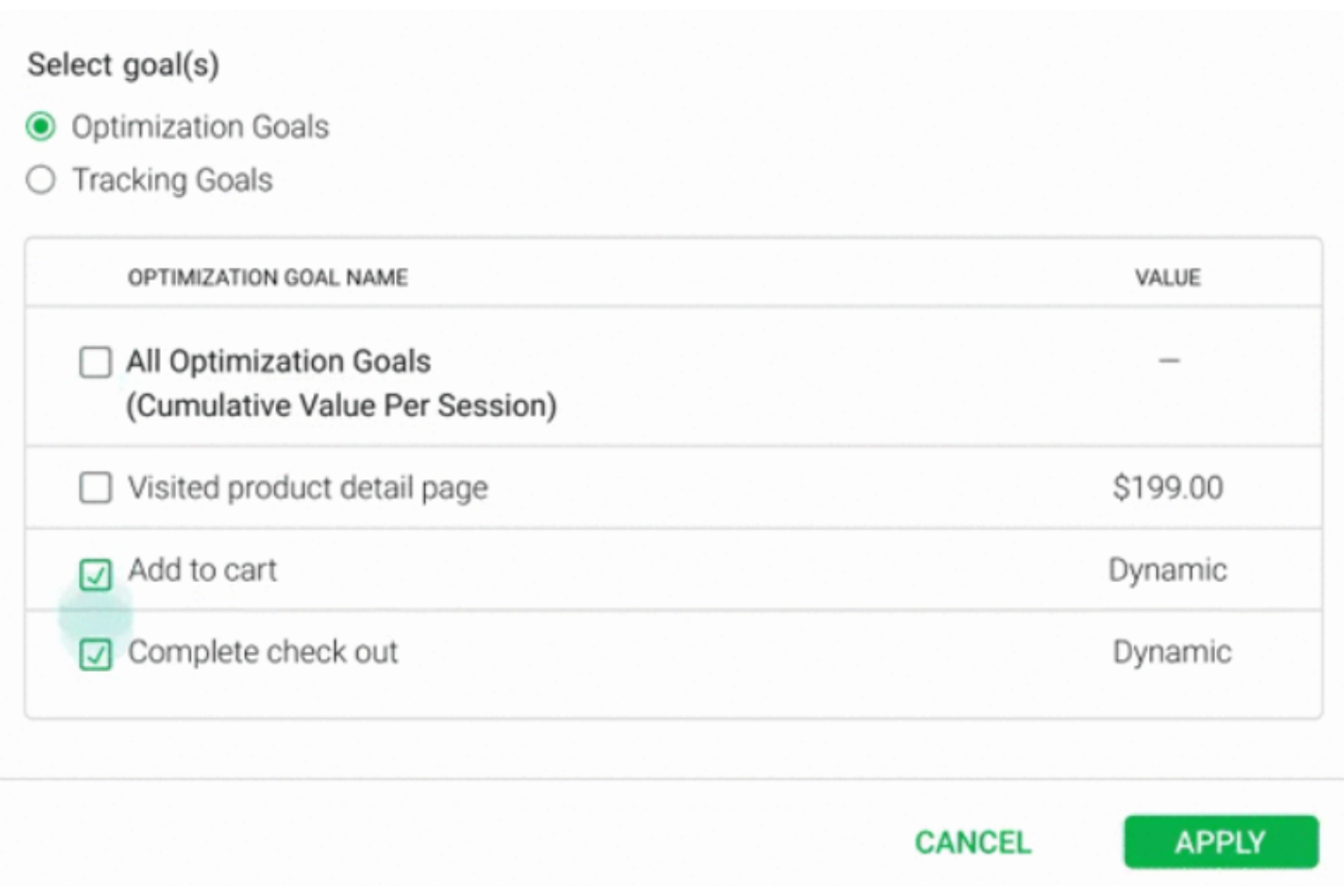10 Best A/B Testing Software Shortlist
Here's my pick of the 10 best software from the 18 tools reviewed.
There are so many different A/B testing tools out there that choosing the best one for you can be tricky. You want to identify the most effective design or content changes by systematically comparing variations and continuously improving the user's experience with your products but need the right tool for the job. I've got you covered! In this post, I leverage my experience in product management using many different platforms with larger teams, and complex products to share my picks of the best A/B testing software.
What Is A/B Testing Software?
A/B testing software is an online tool that enables you to run controlled experiments on two versions of an idea (web page design, product feature, marketing flow, etc.) to determine the better-performing variant. Through experiment setup and management, statistical analysis, integration with analytics tools, and the ability to test variations of elements such as headlines, images, or call-to-action buttons, it helps you better understand user preferences.
You can use A/B testing software to decide which idea yields the best results regarding user engagement, conversions and other metrics.
Overviews Of The 10 Best A/B Testing Software
Here’s my in-depth review of each tool. I’ll walk you through the pros and cons, features and functionality to highlight what makes each tool great.
Founded in 2012, Kameleoon has evolved into a comprehensive experimentation platform. Kameleoon offers personalization, full stack and A/B testing features to improve engagement and conversion rates.
Why I picked Kameleoon: I’ve experienced the flicker effect on some ecommerce websites I visited. The flicker effect aka Flash of Original Content (FOOC) is when your original web page “flickers” for a moment before the control page loads. This severely impacts your user experience and may even increase website bounce rates. Kameleoon features an “anti-flicker snippet” functionality that ensures your website experience is entirely flicker-free.
Kameleoon offers the flexibility of a graphic editor and a coding editor (for the technically proficient). Additionally, Kameleoon offers a robust Chrome extension for creating experiments on the fly.
Kameleoon Standout Features and Integrations
One standout feature includes custom business goal definition. You can predefine test criteria that align with your business goals and objectives. As a result, you can track A/B test success for various elements like CTA button text, hero image, headline copy, etc.
Integrations include over 30 integrations with tools like AT Internet, Amplitude, Contentful, Contentsquare, Crazyegg, Frontastic, Git, FullStory, Hotjar, Heap, and Klaviyo. You can also access thousands of additional apps by connecting it to Zapier.
Pros and cons
Pros:
- Dedicated CSM
- Easy to launch A/B tests
- AI personalization features
Cons:
- Limited features in the graphic editor
- Access management isn’t robust
Optimizely is a heavyweight in the Conversion Rate Optimization (CRO) and A/B testing space. Optimizely helps brands worldwide improve customer lifetime value and revenue. With over 10000 customers, Optimizely has three broad product pillars: Orchestrate, Experiment and Monetize. The A/B testing features fall under the Experient product category.
Why I picked Optimizely: As a former product manager, I recall having a constant see-saw of dilemmas when it came to product feature prioritization. Optimizely has an amazing targeted rollout to progressively release new features.
With targeted rollouts (aka feature flags), you can define customized traffic allocations for specific product features. Consequently, you can segment audiences based on various parameters. For instance, you can only roll out a new chatbot feature to beta customers. As a result, you can validate features before pushing them to production.
Optimizely Standout Features and Integrations
One standout feature is AI-generated insights that give you real-time guidance on optimizing content for improving conversions. Additionally, Optimizely also offers AI-powered recommendations for personalizing website and email copy.
Integrations include tools like 6Sense, Figma, FullContact, Glassbox, Hawksearch, Hearsay, Hootsuite, Invoca, Milanote, and Sprout Social. You can build new integrations using the Optimizely integration platform or access thousands of additional apps via Zapier (requires paid plan).
Pros and cons
Pros:
- Robust server-side testing
- Multivariate testing
- Straightforward UI
Cons:
- Challenging to integrate third-party data sources
- Fragmented documentation
VWO is an end-to-end testing optimization platform that helps businesses analyze and make data-driven decisions. VWO has three major product categories, namely Experiment, Observe and Personalize. A/B testing is an offering of the Experiment product module. Some useful behavioral analytics that VWO collects include dead clicks, rage clicks, time spent, drop-offs, and several others.
Why I picked VWO: I used to run a blog back in the day, and I was obsessed with various website metrics like bounce rate, page views, unique visitors and so on. VWO is your go-to if your digital products predominantly feature websites.
VWO offers various web page testing methods, including multivariate, split and A/B testing. Additionally, the platform features a useful visual editor with point-and-click features. You can quickly edit design elements like images, backgrounds, etc., without writing any HTML/CSS code.
VWO Standout Features and Integrations
One standout feature includes out-of-the-box widgets you can leverage to influence user behavior. VWO offers a huge widget library that you can experiment with to improve lead capturing and conversions.
Integrations include tools like 6sense, AT Internet, Adobe Analytics, BigCommerce, Braze, Clearbit, Contentful, Contentsquare, Drupal, and FullStory. Additionally, you can access plugins for content management systems (WordPress) and ecommerce platforms like Shopify.
Pros and cons
Pros:
- Test scheduling
- Robust Bayesian model data analysis
- Easy to customize landing pages
Cons:
- Can’t allocate credits amongst internal teams
- Occasional platform bugs
Founded in 2006, Crazy Egg developed one of the most nascent heatmap technologies to track visitor behavior on websites. Fast forward to the present, and Crazy Egg has many optimization features including A/B testing, error tracking, surveys and more.
Why I picked Crazy Egg: I’m amazed by the Shopify integration that Crazy Egg offers. Right off the bat, Crazy Egg features a “five visual snapshot” that provides heatmaps, scrollmaps and an interesting confetti report that depicts individual clicks on your website.
Crazy Egg provides a robust A/B testing solution. You can quickly tweak elements on your landing or checkout pages to track the corresponding impact on your sales. Additionally, the testing setup is quite simple: You only need to add the Crazy Egg snippet to any web page, and you’re ready.
Crazy Egg Standout Features and Integrations
One standout feature includes shopping cart abandonment analysis. Crazy Egg helps you understand at what point potential shoppers drop-off. You can analyze these website visitors’ browsing patterns and devise A/B testing to convert these “low-hanging fruits.”
Integrations include tools like Drupal, Google Tag Manager, Joomla, Marketo, Segment, Shopify, Squarespace, Wix, WordPress, and others.
Pros and cons
Pros:
- Great heat mapping features
- Campaign duplicating features
- Robust reporting
Cons:
- Session recording replays aren’t very reliable
- Lack of integrations with 3rd party analytics tools
Leanplum’s founders are ex-Google employees who worked on YouTube monetization algorithms. Founded in 2012, Leanplum helps businesses increase customer engagement. Leanplum focuses on mobile website and application A/B testing to draw insights and improve user engagement rates.
Why I picked Leanplum: I’m amazed that changing small elements (like the time of a notification trigger) can result in massive engagement spikes. Leanplum enables you to define parameters that manipulate notification triggers. For instance, you can choose an “immediate” trigger or apply a “delay” based on conditions like whether the user opened a previous notification.
As you test variations, you will soon embark on that secret recipe that maximizes engagement. Leanplum helps you grasp which channels work better based on the collected sample size. For instance, you can analyze and make a data-driven decision between opting for in-app notifications and push notifications.
Leanplum Standout Features and Integrations
One standout feature is the automation of notification workflows. For instance, you can create a customized workflow that defines what kind of notifications would pop up after a day, two days or five days. As a result, you have granular control over your mobile application notification and messaging strategy.
Integrations include Amplitude, Branch.io, Inkit, InMobi, Kochava, Marketo, Twilio, Tune, and Radar. An API is also available for custom integrations.
Pros and cons
Pros:
- Power analytics tools
- Great data segmentation
- Robust campaign reporting
Cons:
- Glitches with iOS integration
- Occasional sync glitches
Apptimize from Airship helps businesses worldwide iterate to elevate user experience via feature release management and A/B testing. Apptimize is ideal if you’re a mobile application-focused product manager, as the platform has many useful features for optimizing mobile apps.
Why I picked Apptimize: I love the sheer firepower that Apptimize packs into its feature management platform. The software supports the testing of both Android and iOS applications. Moreover, with Apptimize, you can instantly launch A/B tests and tweak around with several elements like navigation, copy, images, etc.
Apptimize offers great feature flagging features that allow you to implement a targeted release of mobile features. The free version allows unlimited feature flag usage (capped at 5 simultaneously).
Apptimize Standout Features and Integrations
One standout feature is cross-platform A/B testing, which allows you to experiment across Android and iOS simultaneously. As a result, you can garner test results from a broader audience and impart a consistent user experience across the two mobile operating systems.
Integrations include tools like Amplitude, Firebase, Flurry, Google Analytics, Localytics, and Mixpanel.
Pros and cons
Pros:
- Personalized user experience
- Easily select a winning variant
- Powerful code editor
Cons:
- Slightly overwhelming dashboard
- Steep learning curve
Split helps engineering and development teams worldwide contribute to “impact-driven development.” Split offers notable feature flagging tools to measure your various features’ impact.
Why I picked Split.io: As a former product manager, I love dissecting features and analyzing what makes a feature successful. Split provides a comprehensive snapshot of your features across the entire application stack, including the backend, frontend and server-side.
With Split, you can conduct A/B tests for every feature. As a result, you can quickly measure feature-wise impact. Depending on your A/B test results, you can decide whether or not to roll out a particular feature.
Split.io Standout Features and Integrations
One standout feature is the dark launch that allows you to push code into production without exposing it to users. As a result, you eliminate unnecessary launch dependencies by continually delivering code. When you are ready to finally go live, you can switch on the feature for real users.
Integrations include tools like AppDynamics, Azure DevOps, Bugsnag, Datadog, Dynatrace, Grafana, Jenkins, Jira Cloud, Librato, Sentry, and others.
Pros and cons
Pros:
- User targeting features
- Dynamic configuration
- Detailed documentation
Cons:
- Slightly steep learning curve
- Glitches with mobile app feature flags
Intellimize leverages machine learning (ML) to optimize websites for high conversion rates. Intellimize primarily targets businesses in the ecommerce and SaaS niches. AI Optimize is an exciting product that Intellimize recently introduced to garner AI-inspired suggestions for your websites.
Why I picked Intellimize: Ever since chatGPT burst onto the scene, I’ve always looked for tools that embrace AI. Intellimize epitomizes AI adoption. Intellimize AI features a highly trained model that has analyzed over 10 billion web pages.
While Intellimize also offers conventional A/B testing features, AI optimization is an interesting twist to experimentation. You can set optimization goals and quickly initiate testing on unlimited variations. With AI Optimize, Intellimize boosts your testing speeds by 25 times over traditional testing mechanisms.
Intellimize Standout Features and Integrations:
One standout feature is the “What You See is What You Get” (WYSIWYG) visual editor that allows you to generate live variations with ease. Thanks to its ease of use, you can easily run tests in minutes. You can use Intellimize’s drag-and-drop interface to edit web page design on the go.
Integrations include tools like 6 sense, Clearbit, Google Analytics, Marketo, Mixpanel, RollWorks, Salesforce, Shopify, and others.
Pros and cons
Pros:
- Multivariate testing
- Great customer support team
- Predictive personalization features
Cons:
- Some features aren’t very user-friendly
- Occasional platform lags
Google Optimize helps you test web page variants to determine the best-performing choice. With Google Optimize, you can leverage other Google solutions like Analytics, Google Ads and Firebase.
Why I picked Google Optimize: Even though it will be sunsetting on September 30 this year, it’s still a powerful tool by Google that helps with website and Ad campaigns. I’ve used Google Ads in the past and remember feeling quite impressed with the sheer abundance of keyword tracking features. With Google Optimize, you can amplify the benefits you reap from Google Ads.
Google Optimize enables you to conduct A/B tests for your Google Ads landing pages. Consequently, you can test and iterate to boost your clickthrough and conversion rates. Google Optimize also features objective-based testing for achieving specific goals. For instance, you can leverage Google Optimize to reduce bounce rates on your Google Ads campaigns.
Google Optimize Standout Features and Integrations:
One standout feature is the Bayesian algorithm. Google Optimize uses the Bayesian inference to refine A/B testing results continually. As a result, you gain access to complex variables like the probability of a variant being successful over another.
Integrations include Google native tools like BigQuery, Firebase, Google Ads, Google Analytics, Google Tag Manager, and others.
Pros and cons
Pros:
- Easy to set up tests
- Generous free version allows unlimited tests
- Intuitive visual editor
Cons:
- Lacks application testing
- Occasional Bugs with anti-flicker
Monetate is a cloud-based platform for website optimization that helps you drive revenue. The platform offers several testing mechanisms, including A/B, multivariate testing (MVT), and A/B/n. Founded in 2008, Monetate focuses on improving businesses customer experience (CX).
Why I picked Monetate: Dynamic testing has always amazed me: Dynamically testing several variants and choosing the best-performing one helps streamline your optimization journey. While Monetate offers robust A/B testing features, the platform’s dynamic testing has impressed me. Dynamic testing helps when your pages receive significantly less traffic (lesser than what’s required for a traditional A/B test).
With dynamic testing, you can determine optimal placements of vital web page elements like product recommendations. Additionally, Monetate leverages various algorithms to explore placement options and dynamically tweak content in real-time.
Monetate Standout Features and Integrations
One standout feature is Monetate’s omnichannel reach. You can easily leverage Monetate’s features across your marketing campaigns, whether email, online, or in-store.
Integrations include tools like Contentsquare, Coremetrics, Google Analytics, Hotjar, SiteCatalyst, and others.
Pros and cons
Pros:
- Real-time analytics
- Support Single Sign On (SSO)
- Effective audience segmentation
Cons:
- Slightly steep learning curve
- Cluttered UI
The Best A/B Testing Software Comparison Chart
Here is a table you can use to compare the tools we just covered in the overviews.
| Tools | Price | |
|---|---|---|
| Kameleoon | Pricing upon request | Website |
| Optimizely | Pricing upon request | Website |
| VWO | From $173/month (billed annually) | Website |
| Crazy Egg | From $29/user/month | Website |
| Leanplum | From $330/month | Website |
| Apptimize | Pricing Upon Request | Website |
| Split | From $33/seat/month | Website |
| Intellimize | Pricing upon request | Website |
| Google Optimize | Pricing upon request | Website |
| Monetate | Pricing upon request | Website |

Compare Software Specs Side by Side
Use our comparison chart to review and evaluate software specs side-by-side.
Compare SoftwareOther A/B Testing Software Options
Here are other tools that did not make it to my best list but are still worth considering:
- LaunchDarkly
Best for customizable feature flagging options
- Adobe Target
Best for performing multivariate analysis
- Omniconvert
Best A/B testing tool for a powerful segmentation engine
- Instapage
Best A/B testing tool for split-testing with heatmaps
- Convertize
Best A/B testing tool for an intuitive, visual page-editor
- Yieldify
Best A/B testing tool for AI-powered predictions
- Statsig
Best A/B testing tool for better product observability
- Oracle Maxymiser
Best A/B testing tool for in-session personalization
Selection Criteria For A/B Testing Software
Here’s a summary of the main selection and evaluation criteria I used to develop my list of the best software:
Core Functionality
Here’s a list of essentials that every A/B testing software has to offer to clinch a spot on my shortlist:
- Offers different types of testing, like A/B testing, multivariate testing and dynamic testing.
- Ships a clean summary dashboard containing A/B test results and insights
Key A/B Testing Software Features
In addition to the core essentials above, here are some vital features that improve the effectiveness of an A/B testing tool. I assessed these factors while building my shortlist:
- User Friction Analysis: Pinpointing uneasiness and friction in a customer journey allows you to tweak the correct digital elements.
- Analytics: Collecting Key Performance Indicators (KPIs) from your A/B tests will help you analyze the effectiveness of various test variants.
- Custom Goal Definition: By tying customer business objectives to A/B tests, you can clearly articulate how vital metrics improve upon testing.
Usability
A/B testing tools that ship an easy-to-use and straightforward UI fare high in my books. Additionally, easy-to-use A/B testing tools pave the way for seamless onboarding. Beginners must get acquainted with an A/B testing tool quickly to create and execute tests on the go.
Software Integrations
I’ve mentioned the various integration possibilities that each tool offers. You can integrate A/B testing software with applications like collaboration tools, third-party analytics tools, CMS tools, and CRM tools.
Pricing
Lastly, the A/B testing software shouldn’t burn a hole in your pocket. I’ve mentioned each tool’s pricing along with their free trial availability. All the tools feature a per-month SaaS subscription charge.
The typical monthly subscription charge varies between $10 up to $2000 per month. Some tools haven’t mentioned pricing so you would need to contact their sales teams for a customized quote.
A/B Testing Software FAQs
Find answers to common questions people ask about A/B testing software:
How do you perform an A/B test?
Here’s a six-step process you can follow for performing effective A/B tests:
- Define your goal: Determine your objectives for the A/B test.
- Identify testing scope: Decide which elements of your digital product you would like to test.
- Create variations: Develop multiple variants of your test elements. For instance, if you’re testing a CTA button, create variants with different combinations of colors, sizes, etc.
- Split traffic: Using A/B testing software, divide incoming traffic amongst your variants.
- Run Tests: Let the testing software run tests and collect data.
- Analyze results: Analyze your results to determine which variant performs better.
What are the types of A/B testing?
Here are some popular types of A/B testing:
- A/B/n testing: This is just an extension of the traditional A/B tests. A/B/n testing involves multiple variants.
- Multivariate testing: MVT involves testing combinations of multiple elements simultaneously. As a result, you can optimize complex pages with various elements to find the best combination.
- Split URL testing: Here, users get directed to entirely different URLs, rather than variations.
- Bandit testing: This involves dynamically allocating incoming traffic to the better-performing variant.
What are the benefits of A/B testing?
A/B testing promises several advantages, including data-driven decision-making and improved user experience. Consequently, you can realize increased conversions and reduced bounce rates.
What’s Next?
Selecting the right A/B testing software can go a long way in unraveling unique insights about improving your customer experience and conversion rates. I hope my guide helps you choose the right A/B testing software that propels your understanding of what elevates your customers’ digital experience.
As a product manager, you must be constantly on edge hunting for ways to refine your digital products. Therefore, you can read about how feature flagging helps you manage a scaling a product, how to gather useful product feedback, or the 6 steps you can take to create a UX research plan.
Related tool lists:
Don’t forget to subscribe to our newsletter for more solutions and strategies from top product management strategists.




















